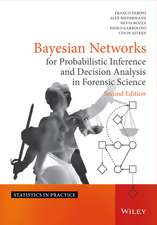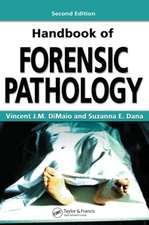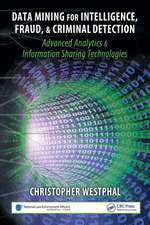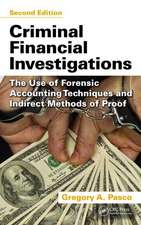Skeletal Trauma: Identification of Injuries Resulting from Human Rights Abuse and Armed Conflict
Autor Erin H. Kimmerle, Jose Pablo Baraybaren Limba Engleză Hardback – 19 feb 2008
Twenty-six leading scholars and practitioners from anthropology, pathology, and forensics contribute their research, cases, photographs, and extensive fieldwork experience to provide 16 representative case studies. Taken from human rights violations, ethnic and armed conflict, and extra-judicial executions throughout the Americas, Europe, and Asia, all evidence in the examples is interpreted through an epidemiological model and set in a legal framework. Several of the exemplary studies, including those from the Balkans, have already been presented as evidence in criminal trials.
| Toate formatele și edițiile | Preț | Express |
|---|---|---|
| Paperback (1) | 368.50 lei 6-8 săpt. | |
| Taylor & Francis – 14 oct 2024 | 368.50 lei 6-8 săpt. | |
| Hardback (1) | 1405.35 lei 6-8 săpt. | |
| Taylor & Francis – 19 feb 2008 | 1405.35 lei 6-8 săpt. |
Preț: 1405.35 lei
Preț vechi: 1713.84 lei
-18% Nou
Puncte Express: 2108
Preț estimativ în valută:
268.94€ • 292.04$ • 225.91£
268.94€ • 292.04$ • 225.91£
Carte tipărită la comandă
Livrare economică 22 aprilie-06 mai
Preluare comenzi: 021 569.72.76
Specificații
ISBN-13: 9780849392696
ISBN-10: 0849392691
Pagini: 528
Ilustrații: 614 black & white illustrations
Dimensiuni: 178 x 254 x 29 mm
Greutate: 1.08 kg
Ediția:1
Editura: Taylor & Francis
Colecția CRC Press
Locul publicării:Oxford, United Kingdom
ISBN-10: 0849392691
Pagini: 528
Ilustrații: 614 black & white illustrations
Dimensiuni: 178 x 254 x 29 mm
Greutate: 1.08 kg
Ediția:1
Editura: Taylor & Francis
Colecția CRC Press
Locul publicării:Oxford, United Kingdom
Public țintă
Academic and Professional Practice & DevelopmentCuprins
An Epidemiological Approach to Forensic Investigations of Violations to International Humanitarian and Human Rights Law. Differential Diagnosis of Skeletal Trauma. Blasting Injuries. Blunt Force Trauma. Skeletal Evidence of Torture. Sharp Force Trauma. Gunfire Injuries. Variation in Gunfire Wounds by Skeletal Region. References Cited. Index.
Notă biografică
Erin H. Kimmerle, Jose Pablo Baraybar
Recenzii
" The authors provide a comprehensive synthesis of skeletal trauma analysis. The presentation of case studies by practitioners with a wealth of experience in the analysis of human skeletal trauma from various countries (particularly those not typically represented in the English language journals), is a major contribution to the disciplines of forensic anthropology and pathology. There is good emphasis on the contextual background and its importance in evaluating findings. This reliance is at the same time a potential weakness, which those practicing in ordinary domestic environments recognize only too well. The evaluation of future events, hitherto hidden in the conduct of war or internal violence, will be substantially advanced by the existence of this book. The authors are to be congratulated and thanked for their work."
-- Professor Stephen Cordner, MA, MB, BS, BMedSc FRCPath, FRCPA, DMJ DipCrim. Stephen Cordner is the foundation Professor of Forensic Medicine at Monash University and Director of the Victorian Institute of Forensic Medicine, Australia
“The publication of this book, which is borne from solid research and extensive practice in the field, is as timely as it is necessary. It is set to become a guiding tool for forensic scientists, human rights activists, and humanitarian workers committed to giving a truthful voice to the dead.”
--From the foreword by Morris Tidball-Binz M.D., Forensic Coordinator, International Committee of the Red Cross, Geneva, Switzerland
“ …use by forensic practitioners and prosecution and defense lawyers will ensure the maximum exploitation of human remains for the purposes of proof in both domestic and international criminal prosecutions.”
--From the foreword by Andrew T. Cayley, J.D., Senior Prosecuting Counsel, International Criminal Court and Former Senior Trial Attorney, International Criminal Tribunal, the former Yugoslavia Republic
“Timely, detailed and authoritative, Kimmerle and Baraybar’s volume on skeletal trauma in contexts of human rights abuses and armed conflict is a “must have” for forensic anthropologists – student and practitioner alike. Others with interests ranging from physical anthropology to human right should also find the work sufficiently non-technical for their needs.”
--Lisa Leppo, Ph.D., US Army Mortuary Affairs Center
“… the most detailed and systematic treatment of skeletal trauma I have read. … a key resource for anyone investigating skeletal trauma.”
--Douglas H. Ubelaker, Ph.D., Curator, Department of Anthropology, National Museum of Natural History, Smithsonian Institution
“In this book, detailed descriptions and photographs of trauma are complimented by case studies demonstrating the application of trauma analysis to human rights investigations. Forensic anthropologists involved in human rights work, as well as students and specialists in other medicolegal fields will find this book to be a useful resource and guide to interpreting trauma in the forensic context.”
--John Verano, Ph.D., Department of Anthropology, Tulane University, New Orleans, Louisiana
“Skeletal Trauma: Identification of Injuries Resulting from Human Rights Abuse and Armed Conflict is a remarkable text that gives an in-depth accounting of the scientific approach used in the mortuary to investigate and document human rights abuses. This well-researched manuscript offers an epidemiological approach to discriminate war casualty from acts of genocide and the methods to scientifically document skeletal trauma from potential causes including torture, gunshot injury, blast force injury, and blunt and sharp force trauma. Emphasized are the flexibility and rigorousness needed in human rights investigations where optimal laboratory and mortuary conditions are rarely obtainable. The authors have many years of experience in establishing mortuary and field recovery operations that have withstood the rigors of court readiness thus establishing them as true authorities on this subject matter. They have compiled contributions from twenty-six specialists in forensic anthropology, forensic pathology, criminalistics, and legal medicine who themselves are at the forefront of International human rights investigations. This text will serve as a reference for the audience member seeking to establish or interact with human rights investigations. The comprehensive review of trauma interpretation from the skeleton ensures that this volume will be adopted in the classroom and used by the professional as the exemplary text on skeletal trauma.”
-- Dana Austin, Ph.D., Diplomate, American Board of Forensic Anthropology Senior Forensic Anthropologist, Tarrant County Medical Examiner’s District, Fort Worth, Texas
…" a well-referenced, well-organized text … an excellent pictorial guide illustrating each type of trauma encountered in skeletal analysis and demonstrating a systematic method to adequately document and interpret skeletal trauma. … The case studies provide a realistic view of the difficulties facing an anthropologist working in subpar conditions and within an emotionally charged environment. … The text is a valuable resource for both forensic anthropology students, as well as seasoned practitioners."
—J.C. Love, Harris Country Medical Examiner’s Office, Houston, Texas, writing in Forensic Science, Medicine and Pathology
<qu>" … this book is interesting, is highly pertinent in today’s socio-political climate, and is a noble effort to be applauded.
<source>—Tim Thompson, School of Science & Technology, University of Teesside
-- Professor Stephen Cordner, MA, MB, BS, BMedSc FRCPath, FRCPA, DMJ DipCrim. Stephen Cordner is the foundation Professor of Forensic Medicine at Monash University and Director of the Victorian Institute of Forensic Medicine, Australia
“The publication of this book, which is borne from solid research and extensive practice in the field, is as timely as it is necessary. It is set to become a guiding tool for forensic scientists, human rights activists, and humanitarian workers committed to giving a truthful voice to the dead.”
--From the foreword by Morris Tidball-Binz M.D., Forensic Coordinator, International Committee of the Red Cross, Geneva, Switzerland
“ …use by forensic practitioners and prosecution and defense lawyers will ensure the maximum exploitation of human remains for the purposes of proof in both domestic and international criminal prosecutions.”
--From the foreword by Andrew T. Cayley, J.D., Senior Prosecuting Counsel, International Criminal Court and Former Senior Trial Attorney, International Criminal Tribunal, the former Yugoslavia Republic
“Timely, detailed and authoritative, Kimmerle and Baraybar’s volume on skeletal trauma in contexts of human rights abuses and armed conflict is a “must have” for forensic anthropologists – student and practitioner alike. Others with interests ranging from physical anthropology to human right should also find the work sufficiently non-technical for their needs.”
--Lisa Leppo, Ph.D., US Army Mortuary Affairs Center
“… the most detailed and systematic treatment of skeletal trauma I have read. … a key resource for anyone investigating skeletal trauma.”
--Douglas H. Ubelaker, Ph.D., Curator, Department of Anthropology, National Museum of Natural History, Smithsonian Institution
“In this book, detailed descriptions and photographs of trauma are complimented by case studies demonstrating the application of trauma analysis to human rights investigations. Forensic anthropologists involved in human rights work, as well as students and specialists in other medicolegal fields will find this book to be a useful resource and guide to interpreting trauma in the forensic context.”
--John Verano, Ph.D., Department of Anthropology, Tulane University, New Orleans, Louisiana
“Skeletal Trauma: Identification of Injuries Resulting from Human Rights Abuse and Armed Conflict is a remarkable text that gives an in-depth accounting of the scientific approach used in the mortuary to investigate and document human rights abuses. This well-researched manuscript offers an epidemiological approach to discriminate war casualty from acts of genocide and the methods to scientifically document skeletal trauma from potential causes including torture, gunshot injury, blast force injury, and blunt and sharp force trauma. Emphasized are the flexibility and rigorousness needed in human rights investigations where optimal laboratory and mortuary conditions are rarely obtainable. The authors have many years of experience in establishing mortuary and field recovery operations that have withstood the rigors of court readiness thus establishing them as true authorities on this subject matter. They have compiled contributions from twenty-six specialists in forensic anthropology, forensic pathology, criminalistics, and legal medicine who themselves are at the forefront of International human rights investigations. This text will serve as a reference for the audience member seeking to establish or interact with human rights investigations. The comprehensive review of trauma interpretation from the skeleton ensures that this volume will be adopted in the classroom and used by the professional as the exemplary text on skeletal trauma.”
-- Dana Austin, Ph.D., Diplomate, American Board of Forensic Anthropology Senior Forensic Anthropologist, Tarrant County Medical Examiner’s District, Fort Worth, Texas
…" a well-referenced, well-organized text … an excellent pictorial guide illustrating each type of trauma encountered in skeletal analysis and demonstrating a systematic method to adequately document and interpret skeletal trauma. … The case studies provide a realistic view of the difficulties facing an anthropologist working in subpar conditions and within an emotionally charged environment. … The text is a valuable resource for both forensic anthropology students, as well as seasoned practitioners."
—J.C. Love, Harris Country Medical Examiner’s Office, Houston, Texas, writing in Forensic Science, Medicine and Pathology
<qu>" … this book is interesting, is highly pertinent in today’s socio-political climate, and is a noble effort to be applauded.
<source>—Tim Thompson, School of Science & Technology, University of Teesside
Descriere
Written to assist in large-scale investigations of human rights violations, this seminal work describes the mechanisms of injuries, synthesizes variations in wounding patterns, and constructs an epidemiological framework for collecting, analyzing, and interpreting physical evidence for use at trial. It presents protocols for systemic data collection and methods for differential wound diagnosis. Contributions evaluate blasting injuries, blunt force trauma, skeletal evidence of torture, sharp force trauma, and gunfire injuries. Illustrated with more than 600 photographs, each chapter discusses wounding mechanisms, wound pathophysiology, relevant legal examples, and contributed case studies.
















